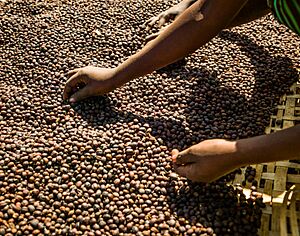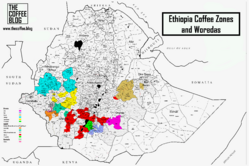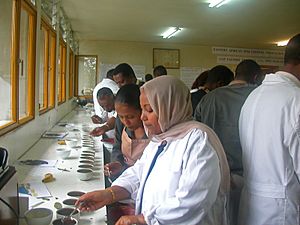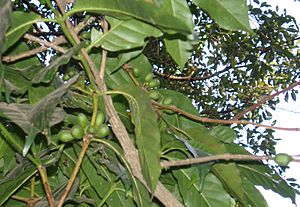Coffee production in Ethiopia facts for kids

Coffee has been grown in Ethiopia for hundreds of years. Ethiopia is the birthplace of the Coffea arabica plant, which is the most common type of coffee. Today, this plant is grown all over the world. Ethiopia produces about 17% of the world's coffee.
Coffee is super important for Ethiopia's economy. About 30-35% of the money the country earns from other countries comes from coffee. Around 15 million people in Ethiopia make a living from growing or selling coffee. In 2013, Ethiopia sold $300 million worth of coffee to other countries. This was about a quarter of all its exports that year.
Contents
Where Did Coffee Come From?
The coffee plant first grew in the Kaffa region of Ethiopia. A popular story says that a goat herder named Kaldi discovered coffee in the 9th century. He noticed his goats became very energetic after eating berries from a certain plant. This story was first written down in 1671.
After starting in Ethiopia, coffee became a drink in Yemen, possibly around the 6th century. From Yemen, coffee spread to cities like Istanbul, Cairo, and Damascus. The first coffee houses in Europe opened in Venice in 1645. The first coffee house in the United States opened in Boston in 1689. Coffee became much more popular in the 1960s. This led to the first Starbucks store opening in Seattle in 1971.
How Did Politics Affect Coffee?
From 1974 to 1991, Ethiopia was ruled by a government that controlled many things. During this time, coffee farms were combined into large, government-run farms. Farmers had to sell their coffee to the government at a very low price.
After 1991, the government changed. Farms were then allowed to form groups called cooperatives. These groups could set fair prices for their coffee. In 2008, the Ethiopia Commodity Exchange (ECX) was created. Its goal was to make trading crops, including coffee, more efficient.
What is the ECX?
Through the ECX, coffee is sorted and grouped by quality. Then, it is sold to the buyer who offers the highest price. The ECX has helped make Ethiopian coffee taste more consistent. It has also helped growers get better prices. However, it made it harder to know exactly where a coffee came from. This means coffee roasters sometimes can't tell you the exact farm or region. The ECX currently handles 90% of Ethiopia's coffee. But, buying coffee directly through farmer cooperatives is becoming more common.
How is Coffee Produced in Ethiopia?
Ethiopia is the fifth largest producer of coffee in the world. It is also the top producer in Africa. In 2022, Ethiopia produced 496,200 tonnes of coffee. Over 4 million small farmers grow coffee there. Half of the coffee grown in Ethiopia is actually consumed by Ethiopians themselves. Ethiopia drinks more coffee than any other country in Africa.
The main buyers of Ethiopian coffee are the European Union (about half of exports), East Asia (about a quarter), and North America. The total land used for growing coffee is about 4,000 square kilometers (1,500 square miles). The exact size is hard to know because the farms are often small and spread out. The way coffee is produced has not changed much. Almost all the work, from growing to drying, is still done by hand.
Types of Ethiopian Coffee Production
Ethiopian coffees can be grouped into three main types based on how they are grown:
- Forest Coffees: These come from wild coffee trees. They grow mostly in the southwest part of the country.
- Garden Coffees: These trees are usually planted around homes or other buildings.
- Plantation Coffees: These come from trees grown on large, organized farms.
Money from coffee exports makes up 10% of the government's yearly income. Because of this, the coffee industry is very important to the government. However, the government is also trying to grow other industries. This way, the country won't rely so much on coffee.
The Tea and Coffee Authority is a government group that handles everything about coffee and tea. For example, they set the price that coffee washing stations pay farmers. This system started when the government took control of all washing stations. Now, these stations are run by farmer cooperatives. The local coffee market is also carefully controlled with licenses. This helps prevent one company from controlling too much of the market.
What Are Ethiopian Coffee Beans Like?
Ethiopian coffee beans are all from the Coffea arabica species. They can be divided into three main types: Longberry, Shortberry, and Mocha.
- Longberry beans are the largest. They are often thought to have the best quality and flavor.
- Shortberry beans are smaller than Longberry. They are considered high quality in Eastern Ethiopia, where they come from.
- Mocha beans are also very valuable. Mocha Harars are known for their special peaberry beans. These often have rich flavors like chocolate, spice, and citrus.
Famous Regional Coffee Varieties
Ethiopian coffee beans grown in specific regions are kept separate. They are sold under their regional names. These regions include Harar, Yirgacheffe, Limu, Jimma, and Kaffa. Ethiopia owns the trademark rights to these regional names.
Sidama Coffee
It is very likely that coffee first originated in the Sidamo region. Sidamo coffee is well-balanced. It often tastes like berries and citrus, with a bright, tangy flavor. This coffee comes from the Ethiopian highlands. It grows at high elevations, from 1,500 to 2,200 meters (about 4,900 to 7,200 feet) above sea level.
At these high elevations, the coffee beans grow more slowly. This gives them more time to soak up nutrients and develop stronger flavors. The most common flavors in Sidamo coffees are lemon and citrus. Sidamo coffee includes Yirgacheffe Coffee and Guji Coffee, both known for their high quality.
Genika Coffee
"Ethiopia Genika" is a type of Arabica coffee that comes from a single place. It is grown only in the Bench Maji Zone of Ethiopia. Like most African coffees, Ethiopia Guraferda beans are small and grayish. However, they are prized for their deep, spicy, wine-like, or chocolatey taste and flowery smell.
Harar Coffee
Harar coffee comes from the Eastern highlands of Ethiopia. It is one of the oldest types of coffee beans still produced. It is known for its unique fruity, wine-like flavor. The outer shells of the coffee bean are used to make a tea called hasher-qahwa. The Harar bean is medium-sized and has a greenish-yellow color. It has a medium tangy taste and a full body, with a distinct mocha flavor. Harar is a dry processed coffee bean. This means the beans are dried with the fruit still on them. Sorting and processing are done almost entirely by hand. The workers are very skilled at categorizing each bean.
Kaffa Coffee
Kaffa coffee is named after the Kaffa region in southwest Ethiopia. This region is also the birthplace of the Arabica plant, which is the "mother" of all other Arabica coffee plants. Kaffa coffee is not grown on farms or maintained by people. It grows wild in deep forests, between 1,400 to 2,100 meters (about 4,600 to 6,900 feet) above sea level. Kaffa coffee is mostly a "forest coffee," but it can also be found as "semi-forest coffee."
How Climate Change Affects Coffee
Ethiopia's high altitude, good temperatures, and rich soil have always been great for growing coffee. However, Ethiopia is now facing challenges because of climate change. The average yearly temperature in Ethiopia has been rising fast. It is expected to increase by 1.1-3.1 degrees Celsius (2-5.6 degrees Fahrenheit) by 2060.
Rising temperatures can lead to more pests and diseases that harm coffee plants. If these problems are not dealt with, they can cause a lot of coffee to be lost. Also, yearly weather patterns are becoming less predictable. The dry season is getting longer, which means less rainfall in the Ethiopian forests where coffee grows.
In addition, a lot of forests in Ethiopia are being cut down. This harms coffee growing because forests provide shade and help keep the air and soil cool. These climate-related problems could reduce coffee production by 70%. To deal with this, coffee farms might need to move to higher, more suitable areas. This would help keep Ethiopian coffee production going and protect the country's economy.
Farmers can also use special methods to help their coffee plants. These include:
- Irrigation: Adding water to the soil.
- Tree shade management: Protecting the forest cover.
- Mulching: Adding material to the soil to keep it healthy.
- Terracing: Building steps on hillsides to improve soil quality and reduce water runoff.
- Pruning: Trimming plants to help them grow better.
Starbucks and Ethiopian Coffee
In 2006, an organization called Oxfam accused Starbucks of trying to stop Ethiopia from trademarking three of its famous coffee beans: Sidamo, Harar, and Yirgacheffe. Oxfam said this could prevent Ethiopian coffee farmers from earning up to £47 million (about $60 million) more each year.
Ethiopia and Oxfam America wanted Starbucks to sign an agreement. This agreement would help farmers get better prices for their coffee. Starbucks was making a lot of money from Ethiopia's famous coffee brands like Guji, Sidamo, Yirgacheffe, and Harar. But the farmers who grew the beans were getting very low prices.
Robert Nelson, who led the National Coffee Association (NCA), said his group opposed the trademark for economic reasons. He said, "For the U.S. industry to exist, we must have an economically stable coffee industry in the producing world." He thought Ethiopia's plan might hurt its own farmers by making their coffee too expensive.
Starbucks received over 92,000 letters from people who were concerned. Starbucks put out flyers in its stores, saying Oxfam was "misleading" people. On November 7, The Economist magazine said Oxfam's view was "simplistic" and Ethiopia's government was "economically illiterate." It argued that Starbucks' approach would help farmers more in the long run.
Finally, on June 20, 2007, Ethiopia's government and leaders from Starbucks Coffee Company announced an agreement. This deal covered how Ethiopian specialty coffees would be sold, marketed, and licensed. It recognized how important and unique Ethiopia's coffee names were. The financial details of the agreement were not shared.
As part of the deal, Starbucks also agreed to promote Ethiopian coffee during two special periods in 2008. A Starbucks spokesperson said this was a "new step" in their relationship with Ethiopia. It was also a way to make Ethiopian coffee more famous around the world. An Oxfam spokesperson said the deal sounded like a "useful step," as long as farmers were benefiting. They added that it was a big change from earlier years when Starbucks was not working directly with Ethiopians to add value to their coffee.
See also
- Agriculture in Ethiopia
- Coffee ceremony
- Oromia Coffee Farmers Cooperative Union
- List of countries by coffee production




